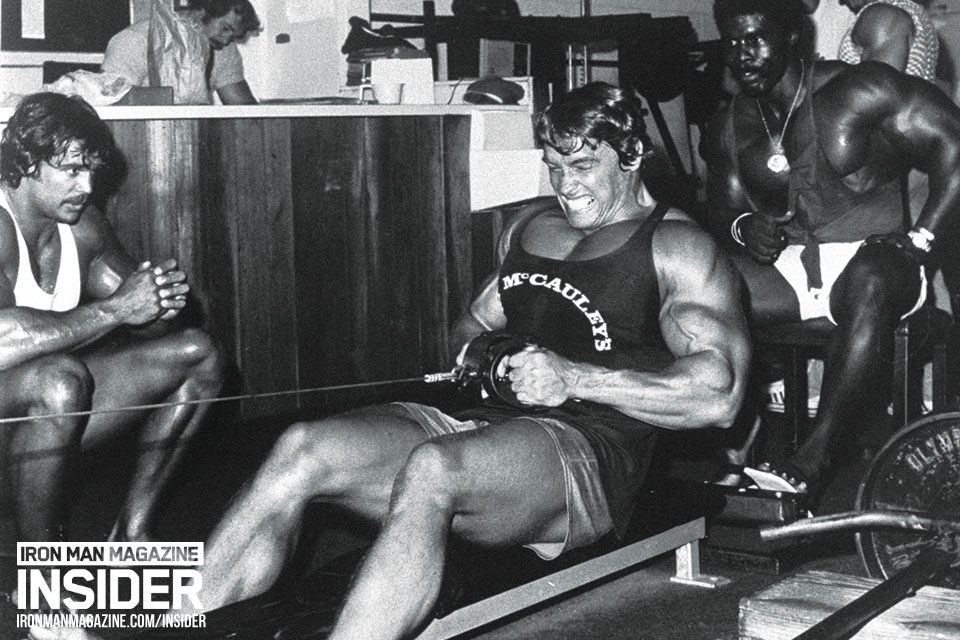


Q: Some of the guys where I train do the low-cable row with a lot of to-and-fro torso movement. Is that correct, or should the torso be fixed during the exercise?
A: Keep your torso upright and rigid throughout each rep. Imagine that your torso is supported and can’t move. If you lean back beyond the vertical, at least with a demanding weight, you’ll probably round your shoulders, be unable to crush your shoulder blades together and rob yourself of working the target muscles.
Also, don’t relax your shoulders between reps to permit a full stretch. A full stretch puts great stress on the rotator cuff muscles at the back of your shoulders and will set you up for an injury. Keep your shoulders tight.
Smoothly pull the bar into your upper abdomen or lower chest, according to what feels most natural for you according to the lengths of your torso and arms. Keep your forearms parallel to the floor, and don’t let your elbows drift out to the sides. Your elbows should be equally spaced throughout the set. Arch your back slightly as you crush your shoulder blades together, but do not lean back. Your elbows should not rise when you’re in the contracted position—keep your forearms parallel to the floor.
Hold the contraction for a second, and then let the resistance pull your elbows straight in a controlled manner. Pause for a second in the starting position, but don’t relax your shoulders. Then smoothly move into the next rep.
Each phase of a rep should take two to three seconds, plus an additional second for holding the contracted position and another second at the starting position.
Look forward at all times, and keep your head in a neutral position—don’t turn, crane or extend your head.
Other common mistakes on the low-cable row involve the choice of bar and the grip width. Use a shoulder-width supinated grip on a straight bar, a pronated grip a little wider than shoulder-width on a straight bar or, best of all, a shoulder-width parallel grip—a special attachment.
One of the most common mistakes trainees make with this exercise is holding their hands too close. A shoulder-width grip produces a better effect than a narrow grip because it keeps the forearms parallel and in a more natural position.
For the parallel grip, if the gym where you train doesn’t already have a shoulder-width bar, encourage the management to get one—preferably one that’s adjustable. Aim for a grip spacing that keeps your forearms parallel throughout the exercise.
To simplify the technique, use a row machine that has a pad that rests against your chest. Set the height of the seat to suit you for the correct rowing pathway, and keep your torso fixed against the chest pad. Also apply the above pointers for the low-cable row.
Q: I can perform just four chinups. No matter how hard I try, I can’t seem to be able to do more than four full reps. This exercise is supposed to be a good one, but if I can’t do more than four, I don’t see how it can do me any good. What should I do?
A: The chinup, done with a supinated grip, or undergrip, is an excellent exercise when it’s done with correct technique, for sufficient reps, and, eventually, with substantial resistance in additional to bodyweight. The pullup, done with a pronated grip, or overgrip, is also a very good exercise. I prefer the chinup because it involves the arm flexors and abs more than the pullup does. Use a closer hand spacing with the chinup than with the pullup.
The minimum starting resistance is bodyweight unless you have access to one of the devices with a counterbalance platform that enables you to reduce your starting resistance to well below your bodyweight and build up as your strength increases. If you don’t have access to one of those devices, stay with the pulldown machine until you can handle in correct technique at least your bodyweight on the machine. At that point move to regular chinups or pullups.
Your ability to pull yourself up is influenced by your bodyfat percentage and your bodyweight in general. The more bodyfat you have, and the heavier you are, the harder this exercise will be. Some lean male beginners do very well at this exercise, but many experienced bodybuilders are poor at it because they are heavy. Plus women generally struggle with both chinups and pullups.
No matter where you are with these exercises now, work to improve. Use a counterbalance chinup/pullup machine, or stick with the pulldown machine. Then, when you’re strong enough, move to regular chinups or pullups.
—Stuart McRobert
www.Hardgainer.com
Editor’s note: Stuart McRobert’s first byline in IRON MAN appeared in 1981. He’s the author of the new BRAWN series, Book 1: How to Build Up to 50 Pounds of Muscle the Natural Way, available from Home Gym Warehouse (800) 447-0008 or www.Home-Gym.com.






















You must be logged in to post a comment Login